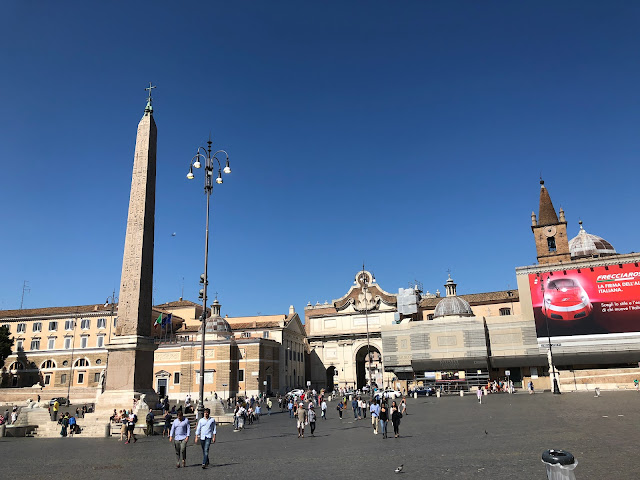【ローマ】多くの巡礼者を迎えたポポロ広場 Roma - Popolo Square welcomed many pilgrims
コルソ通りにあるゲーテの家において、ゲーテがローマに滞在していた時期を追体験した後で、再びポポロ広場に戻ってきた。
ローマには多くの広場があるが、ナヴォナ広場、スペイン広場、そしてこのポポロ広場が3大広場と言われている。
奇しくも、この日にはその3つの広場を訪れることができた。
ポポロ広場は、かつてはローマに巡礼に訪れた人々が最初に訪れる場所だった。ローマ市内に入るために、巡礼者や旅人は、ここで手荷物などを検査されて、市内に入ることを許された。
At Goethe's house on Corso Street, I returned to Piazza Popolo after reliveing Goethe's stay in Rome.
There are many squares in Rome, but Navona Square, Spain Square, and this Piazza del Popolo are said to be the three major squares.
Strangely, I was able to visit the three squares on this day.
Piazza del Popolo was once the first place for pilgrims to Rome. To enter the city of Rome, pilgrims and travelers were allowed to enter the city after being inspected for baggage and other items.
この広場の巡礼者たちを迎えた巨大なポポロ門が作られたのは、ルネサンス期の1475年。教皇シクストゥス4世によって計画された。
シクストゥス4世は、システィーナ礼拝堂やヴァチカン図書館を作った教皇として知られている。他にも多くの建築をローマに建てて、ローマを中世の古いローマからルネサンスの新しいローマへ作り変えた教皇。
その一方で、フレンツェのメディチ家の転覆を狙ったパッツィ家の陰謀の黒幕でもあり、二面性を持った教皇でもあった。
この新たなポポロ門が出来るまでは、この場所には古代ローマ時代に建てられたフラミニア門が建っていた。
外側のファサードは、ピウス4世の注文で1563年から1565年にかけて作られた。設計はミケランジェロが行ったが、その完成を目にすることなく1564年に亡くなっている。
門の内側にもファサードがあり、こちらは1655年12月23日にスウェーデンのクリスティーナ女王をローマに迎えるために、ベルニーニが設計した。
ゲーテは『イタリア紀行』の中で、このポポロ門を目にして初めてローマに来たということを実感した、と記している。
The huge Porta del Popolo, which welcomed the pilgrims in this square, was built in 1475 during the Renaissance. Planned by Pope Sixtus IV.
Sixtus IV is known as the Pope who built the Sistine Chapel and the Vatican Library. He built many other buildings in Rome, transforming Rome from an old medieval Rome to a new Renaissance Rome.
On the other hand, he was also the mastermind behind the Pazzi conspiracy to overthrow the Medici family in Florence, and was also a two-sided pope.
Prior to the creation of this new Porta del Popolo, the Flaminia Gate, built during the ancient Roman period, stood in this place.
The outer façade was ordered by Pope Pius IV from 1563 to 1565. It was designed by Michelangelo, but died in 1564 without seeing its completion.
There is also a façade inside the gate, designed by Bernini to welcome Queen Christina of Sweden to Rome on December 23, 1655.
Goethe wrote in his "Italienische Reise" that he realized that he had come to Rome for the first time when he saw the Porta del Popolo.
ポポロ広場の市内から見て右側には、ローマの神々の彫像で飾られた巨大な噴水が、ピンチョの丘の麓をうまく利用して建てられている。
ローマがナポレオンのフランスの占領下にあった1810年に、ジュゼッペ・ヴァラディアによって計画されたポポロ広場の改築プロジェクトの成果の一つだが、美術史家のマリオ・プラーツは、そのプロジェクトは”不釣り合いな姿をさらす結果”に終わったと批判している。
On the right side of the city of Popolo Square, a huge fountain decorated with statues of Roman gods is built at the foot of the Passeggiata del Pincho.
One of the fruits of a project to reconstruct Piazza del Popolo planned by Giuseppe Valadia in 1810, when Rome was under the French occupation of Napoleon, art historian Mario Praz said the project was "disproportionate." It is criticized that it ended in "the result of exposing."
しかし、上りきった後でポポロ広場を見下ろすと、その疲れを一気に忘れさせてくれる絶景が迎えてくれる。
遠くには、サン・ピエトロ大聖堂の巨大なドームまで見渡せる。
広場の真ん中には、巨大なオベリクスが建っている。フラミニアのオベリスクと呼ばれていて、古代ローマの皇帝アウグステゥスがエジプトのヘリオポリスから持ってこさせたというラムセス2世のオベリスクだ。
このオベリスクは、1589年にシクストゥス5世の依頼でドメニコ・フォンターナによってこの場所に移された。
フラミニアのオベリスクという名前は、かつてはこのポポロ広場から外に向かう街道の名前がフラミニア街道と呼ばれていたことに由来する。
シクストゥス5世は、他にもオベリスクをサン・ピエトロ広場の中央にフォンターナに建てさせるなど、オベリスクを利用してローマの都市建築を行い、先のシクトストゥス4世を引き継ぐ形で、ルネサンスのローマから今度はバロックのローマを作り上げた教皇だ。
ローマの3大広場には、どの広場にもローマという都市の歴史や、そこに関わった人々の足跡が濃厚に刻み込まれている。
You can take the stairs from Popolo Square to the top of the Passeggiata del Pincho, but it's quite painful.
However, if you look down at Popolo Square after climbing up, you will be greeted by a magnificent view that will make you forget the tiredness at once.
In the distance, you can even see the huge dome of St. Peter's Basilica.
In the middle of the square is a huge Oberix. It is called the Flaminia obelisk, and it is the obelisk of Ramses II that the ancient Roman emperor Augustus brought from Heliopolis in Egypt.
This obelisk was moved to this place by Domenico Fontana at the request of Pope Sixtus V in 1589.
The name of the obelisk of Flaminia comes from the fact that the name of the road going out from this Popolo Square was once called the Flaminia Highway.
Sixtus V also used the obelisk to build a Roman city, such as building an obelisk in the center of St. Peter's Square in the center of St. Peter's Square. Is the Pope who created Baroque Rome.
The history of the city of Rome and the footprints of the people involved in it are deeply engraved on each of the three major squares of Rome.






コメント
コメントを投稿